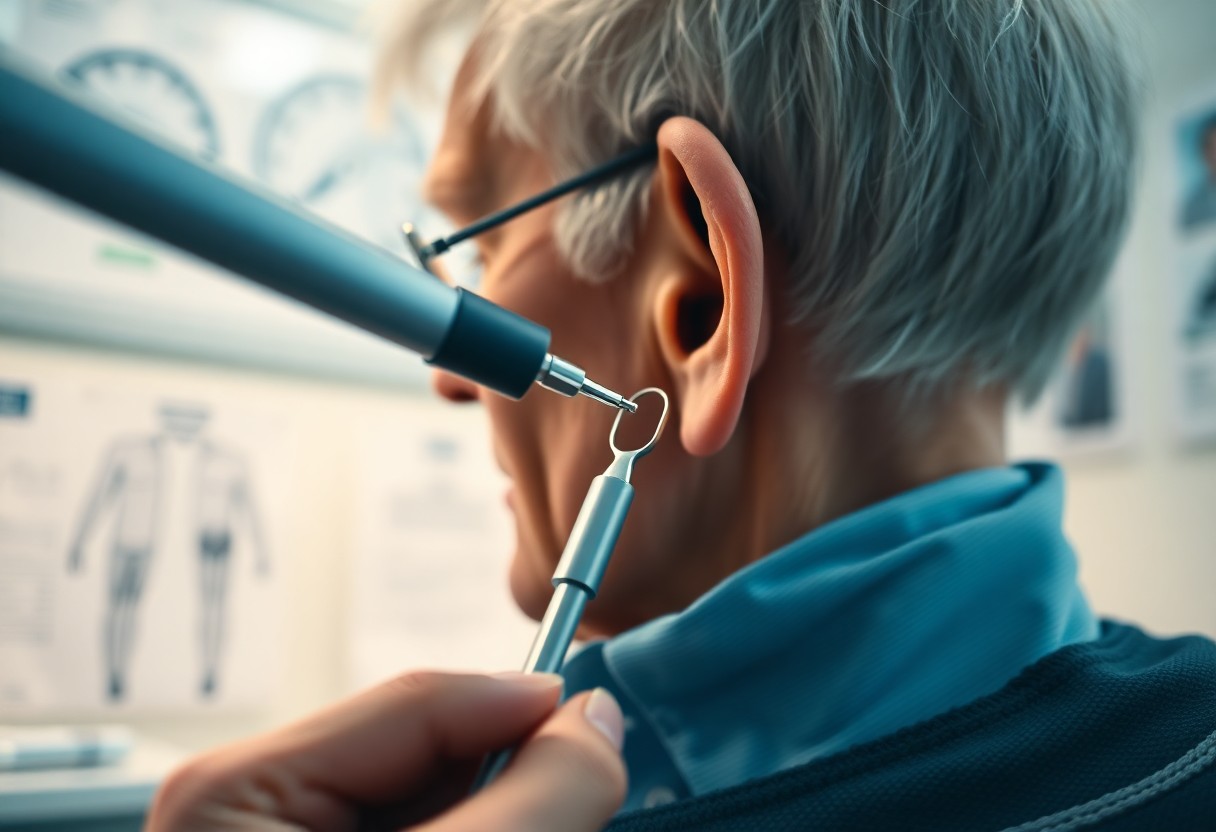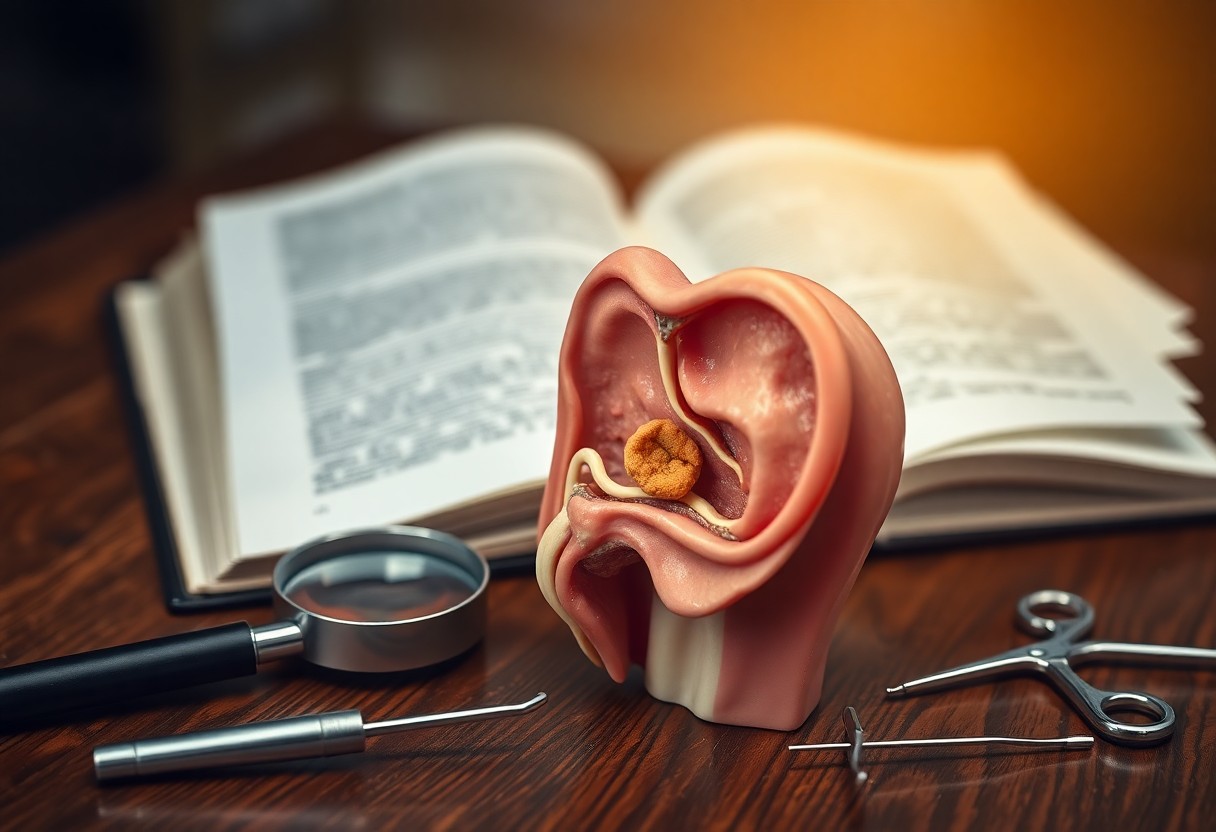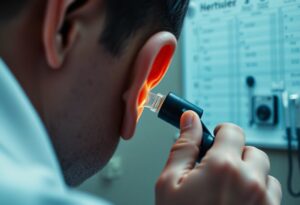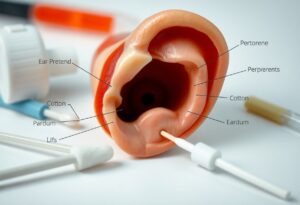It’s vital to understand that as you age, your body’s natural processes change, including earwax production. The elderly often experience drier skin and reduced earwax drainage, leading to a higher likelihood of cerumen impaction. Additionally, factors such as the use of hearing aids, medical conditions, and difficulty with personal hygiene can exacerbate this issue. Knowing the reasons behind this increased susceptibility can help you take proactive steps to maintain your ear health and prevent any discomfort or complications associated with impacted earwax.

Key Takeaways:
- The production of earwax can increase with age, leading to a higher likelihood of cerumen impaction.
- Changes in ear canal shape and elasticity with aging can prevent proper earwax drainage.
- Older adults may use hearing aids or earbuds, which can contribute to wax buildup and impaction.
The Physiological Changes of Aging and Their Impact on Ear Health
Decreased Earwax Production
Your body naturally produces less earwax as you age, often leading to drier, less efficient earwax that can become hard and impacted. This reduced secretion diminishes the ear’s ability to self-cleanse, increasing the risk of blockages that can impair hearing and lead to discomfort.
Changes in Ear Canal Structure
Aging alters the structure of your ear canal, making it more prone to cerumen accumulation. The skin lining can become thinner and lose elasticity, which can create tight spaces that trap wax. Additionally, age-related changes in jaw movement might affect how effectively the ear canal opens and closes, further complicating ear health.

Understanding Cerumen: The Key Functions of Earwax
Protective Qualities of Cerumen
Cerumen acts as a natural barrier, preventing debris, dust, and microorganisms from entering your ear canal. This sticky substance captures unwanted particles and helps to keep your inner ear clean and free from infections. Additionally, cerumen contains antimicrobial properties that inhibit the growth of bacteria and fungi, further safeguarding your auditory system.
The Role of Cerumen in Ear Health
Cerumen plays a significant role in maintaining your ear health by ensuring that your ear canal remains moist. This moisture is crucial, as it helps prevent the skin in the ear from becoming dry and irritated, which can lead to itchiness or discomfort. The presence of cerumen also facilitates the natural shedding of dead skin cells and other debris, ensuring that your ear continues to function optimally.
Moreover, a balanced amount of earwax contributes to overall ear health by cushioning the delicate structures within the ear canal. Without sufficient cerumen, you might experience increased vulnerability to external irritants and potential ear infections. Maintaining its natural state allows for the proper functioning of hearing capabilities and can reduce the need for medical interventions related to ear blockages or irritations.
The Role of Medications and Health Conditions
Common Medications That Contribute to Impaction
Certain medications commonly prescribed to older adults can lead to increased earwax production or contribute to blockage. For instance, antihistamines, often used for allergies, can dry out mucus membranes, causing your earwax to become harder and more difficult to expel naturally. Additionally, some antidepressants and diuretics can alter your body’s hydration levels, further exacerbating the risk of cerumen impaction.
Chronic Illnesses and Earwax Accumulation
Chronic illnesses can significantly impact earwax accumulation in older adults. Conditions such as diabetes and autoimmune disorders may impact skin health and glandular function, resulting in either excessive wax production or impaired clearance mechanisms. For instance, diabetes can lead to peripheral neuropathy, reducing your sensitivity to sensations in the ear that would usually prompt you to seek care for blockage.
The Influence of Personal Care Habits on Earwax Management
Common Mistakes When Cleaning Ears
You may inadvertently contribute to earwax impaction through common cleaning mistakes. Using cotton swabs to clean your ears can push wax deeper into the canal instead of removing it. Other items like hairpins or fingers can cause similar issues, as they risk damaging the sensitive lining of the ear canal and further compacting the wax.
Hearing Aid Use and Its Side Effects
Using hearing aids can lead to increased earwax buildup due to the device’s occlusive nature. When you wear a hearing aid, it can trap moisture and debris in your ear canal, which may stimulate more wax production and lower your ability to manage ear hygiene effectively.
The interaction of hearing aids with earwax can create a cycle of discomfort. As wax accumulates around the hearing aid, it not only affects sound quality but also can cause irritation and inflammation, leading to potential ear infections. Regular maintenance and cleaning of both your hearing aids and ears are crucial to mitigate these side effects and ensure optimal hearing health.
The Consequences of Cerumen Impaction in the Elderly
Hearing Loss and Communication Barriers
Cerumen impaction commonly results in hearing loss among the elderly, profoundly impacting your ability to communicate. This hearing impairment can create frustration and isolation, leading to difficulties in social interactions and potentially exacerbating cognitive decline. You may find yourself withdrawing from conversations, further affecting your emotional well-being and relationships with family and friends.
Potential for Infections and Other Complications
Cerumen buildup not only hampers hearing but also raises the risk of infections in the ear canal. The trapped moisture and debris can lead to conditions like otitis externa, commonly known as swimmer’s ear, which is more susceptible in older adults. Moreover, untreated infections can escalate, contributing to complications that may require medical intervention.
Infections resulting from cerumen impaction can be particularly alarming for the elderly, as they may experience a rapid decline in health. Symptoms such as pain, discharge, and fever warrant immediate attention, especially since older individuals often have weakened immune systems. Additionally, an untreated ear infection can result in serious conditions like mastoiditis, where the infection spreads to the surrounding bone. Awareness and prompt treatment of cerumen impaction are imperative to prevent these potentially severe complications.
Preventative Strategies for Managing Earwax Health
Recommended Care Practices
You can maintain earwax health by adopting simple care practices. Regularly inspect your ears for excessive wax buildup and clean the outer ear with a damp cloth. Avoid inserting cotton swabs or other objects into the ear canal, as these can push wax further in, exacerbating impaction. Consider using mineral oil or saline drops weekly to soften earwax, aiding its natural movement toward the outer ear.
Professional Treatments and Their Benefits
Seeking professional help for earwax management can significantly benefit your ear health. Audiologists and otolaryngologists can provide safe and effective treatments, such as irrigation or manual removal, ensuring complete extraction without damaging sensitive structures in the ear.
Professional treatments often include ear irrigation, where warm water is gently introduced into the ear canal to help flush out excess wax. Manual removal, using tools specifically designed for this purpose, allows for precise extraction and reduces the risk of injury. Many individuals report immediate relief from symptoms following these procedures, highlighting the advantages of seeking expert assistance rather than attempting removal at home. Regular check-ups can also facilitate early intervention, preventing complications related to cerumen impaction.
The Role of Healthcare Providers in Prevention and Education
Importance of Regular Ear Check-Ups
Regular ear check-ups are vital for catching cerumen impaction early, especially in elderly patients. During these visits, healthcare providers can assess earwax levels and provide appropriate cleaning if necessary. These evaluations not only prevent further complications such as hearing loss but also allow for timely interventions that enhance overall auditory health. Regular appointments can be incorporated into routine health assessments, ensuring ear health is not overlooked.
Educating Patients and Families on Ear Health
Education about ear health empowers both patients and their families to take proactive steps in preventing cerumen impaction. Healthcare providers should offer clear information on the ear’s anatomy, the risks of excessive earwax buildup, and the importance of maintaining ear hygiene. Handouts, seminars, or one-on-one discussions can effectively reinforce these concepts, making ear health a topic of consideration in daily routines.
Utilizing visual aids and demonstrations can significantly enhance understanding. For example, showing the correct way to clean ears and explaining the potential risks of using cotton swabs can prevent damage. Providing patients and families with guidelines on recognizing warning signs of ear problems—such as changes in hearing or discomfort—ensures they seek help promptly. Engaging them in discussions about lifestyle factors that may affect ear health, such as hydration and nutrition, helps foster a holistic approach to prevention and maintenance.
Conclusion
Considering all points, you will find that the elderly are more prone to cerumen impaction due to factors such as decreased ear canal elasticity, age-related changes in cerumen production, and the likelihood of using cotton swabs. These conditions often lead to a higher accumulation of earwax, which can result in blockages and associated health issues. Acknowledging these risks can help you take proactive steps for better ear health and seek appropriate medical advice when necessary.
FAQ
Q: What is cerumen impaction and why does it occur in the elderly?
A: Cerumen impaction is the buildup of earwax in the ear canal, which can block hearing and cause discomfort. The elderly often experience changes in earwax production and ear canal anatomy, leading to higher risks of impaction.
Q: How do age-related changes in the ear contribute to cerumen impaction?
A: With age, the earwax tends to become drier and harder due to decreased earwax production and changes in skin properties, making it more challenging to self-cleanse and leading to accumulation.
Q: Are certain medications related to an increased risk of cerumen impaction in older adults?
A: Yes, medications that cause dryness, such as antihistamines or certain antidepressants, can lead to decreased moisture in the earwax, resulting in a higher occurrence of impaction.
Q: How does mobility affect the risk of cerumen impaction in the elderly?
A: Limited mobility can hinder the ability to perform regular ear hygiene practices. This can result in a lack of natural self-cleansing, ultimately contributing to an increase in wax buildup.
Q: What preventive measures can help reduce the risk of cerumen impaction in older adults?
A: Regular ear check-ups, maintaining good ear hygiene, and using ear drops specifically designed to soften earwax can help reduce the risk of impaction in the elderly.



